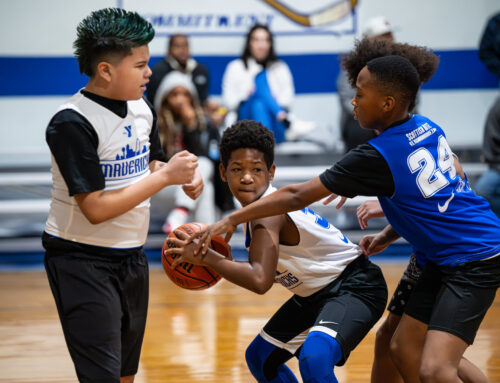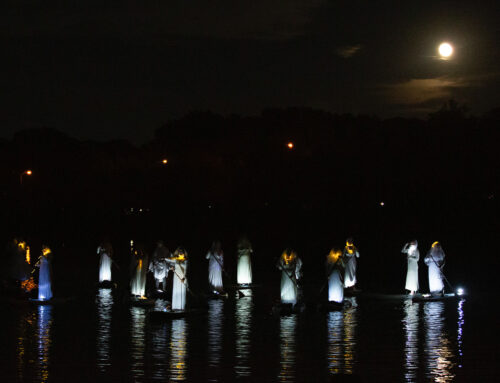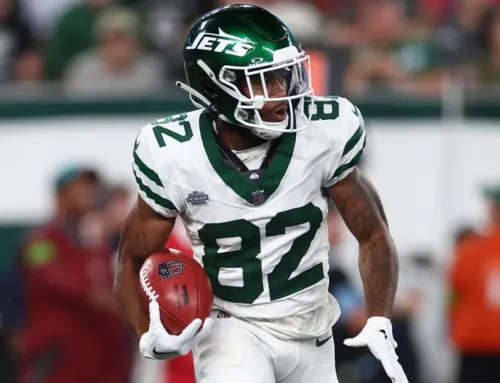It’s halftime at Reunion Arena during a basketball game between the Dallas Mavericks and the Denver Nuggets.
The pros are in the locker rooms, but the action on the court is just heating up.
The stallions, a team of neighborhood third-graders from the East Dallas YMCA, step onto Reunion’s floor to face the Wildcats from the White Rock/Lake Highlands YMCA.
Stallions point guard Drew Bishop gets the ball. The play is a Give-and-Go, a basic basketball maneuver the children have learned in practice. Drew passes the ball to a teammate, cuts toward the hoop, catches a return pass and drives for a lay-up.
The ball rattles around the rim, and the shot drops through the net.
The crowd of more than 17,000 people cheers. Some rise to their feet for a standing ovation. The children stand tall with pride:
When the game ends, the players return to their parents, who watched the young stars from the stands. There are high-fives and pats on the back as the parents and spectators congratulate the children.
The game only lasted about seven minutes, but the memories will last a lifetime.
An Exciting Match-Up
The Stallions are one of 51 teams participating in Mavericks Youth Basketball at the East Dallas YMCA, 6220 Worth.
The Y has run a youth basketball league for years, but last year, the Mavericks joined the program, bringing extra publicity to the Y and opportunities previously unavailable to the children.
Last winter, the Stallions won a Y tournament, and that win earned the team a chance to play at Reunion.
Drew Bishop was among the children to score at Reunion, and it’s an experience he’ll never forget, says his father, Randy Bishop.
“It was a big thrill,” Bishop says. “The kids were really excited about playing.
“When they sunk baskets, they went crazy. That’s a once-in-a-lifetime thing. You could go all your life and not get to play in Reunion Arena.”
This year, the Mavericks plan to give more children a chance to play at Reunion by scheduling more halftime games, says Jim Guy, who founded and directs Mavericks Youth Basketball.
It’s just one of the perks Mavericks sponsorship brings to the Y.
Other benefits include reversible jerseys similar to those worn in the NBA and coaching handbooks. In previous years, the Y couldn’t afford to supply uniforms.
Mavericks support also brings national sponsorships to the Y program, last year from Whataburger and this year from NIKE. Corporate sponsors underwrite a portion of the jersey’s cost and, in return, place their logos on the uniforms.
The Y is charged a fee for the jerseys, but the cost is minimal compared to the cost of uniforms without the Mavericks’ help, says Nora Tomlin, East Dallas YMCA director. The Y seeks out sponsors, but is unlikely to gain the support of corporations such as NIKE on its own, Tomlin says.
The publicity generated by big-name sponsors creates enthusiasm and credibility for the Y program in the neighborhood, Tomlin says.
“It has added excitement and legitimacy for the kids. It’s made them proud,” she says. “I hope it encourages other professional sports teams to help the community.
“They can help without a lot of effort on their part and make a program beneficial for kids.”
Piloting The Program
Mavericks Youth Basketball is in its infant stages. Last season was the program’s pilot year, and the East Dallas Y was the first of four youth organizations to sign up.
This year, six Ys, an Arlington Boys and Girls Club, and two other youth organizations are participating. The program has grown from approximately 2,100 to 8,000 children, and the Mavericks intend to continue expanding their efforts, Guy says.
Mavericks Youth Basketball was inspired by a Utah Jazz program, Guy says, which in 14 years has grown to include more than 70,000 children. Guy is using feedback from the East Dallas Y and other pilot organizations to shape the future of Mavericks Youth Basketball.
“Last year, we were making things up as we went along, which you always do with a new program,” Guy says. “The YMCA is going to have a basketball program whether the Mavericks help or not.
“We want to know what can we bring to the party. We want to find programs doing good jobs and help them do their work.
“For the kids, it gives them an interest in sports. It will give them something they are good at. They’ll be basketball fans, and they’ll be Maverick fans.”
The East Dallas Y has about 510 youth basketball players in kindergarten through ninth grade. The Y’s sports committee was looking for ways to enhance youth basketball when the Mavericks stepped forward, Tomlin says.
“It opened doors,” Tomlin says. “There wasn’t anything we could lose. We didn’t want to be left out in the cold.”
Guy is a Dallas native who grew up playing basketball. He’s in his 16th season with the Mavericks. Two years ago, he was promoted to coordinator of community basketball.
He began his new job by establishing Mavericks summer basketball camps and then expanded Mavericks youth outreach to include the program now at the Y.
After working with Tomlin, he offered the East Dallas Y – at no charge – two full scholarships to the summer camps.
“This is a calling for me,” he says. “I grew up in the gym, and I always had leagues to play in. It’s a great way to grow up. It’s real heard to get in trouble when you’re playing basketball.”
Growing Up at the Y
Lucas Gerken is growing up at the Y and with the Mavericks. He sleeps on Mavericks sheets and rests his head on Mavericks pillows. His bedroom is decorated with Mavericks wallpaper, and his family has had season tickets since long before he was born.
Lucas, a second-grader at Zion Lutheran School, has played Y basketball since pre-school, as well as t-ball and soccer.
Last year, he sported jersey No. 5 in the Y basketball program, the same number worn by Mavericks point guard Jason Kidd, who is Lucas’ favorite player.
The Y is the only neighborhood place that offers basketball for young children, says Lucas’ father, Jim Gerken.
“We’ve had very good experiences with the East Dallas Y,” Gerken says. “It (youth sports) is a chance for kids to socialize with other kids. If it weren’t for the Y, you’d have limited resources to participate.”
Gerken says basketball has been a way for his sons to make friends and for his family to meet other families. Gerken’s oldest son, 10-year-old Rory, played Y basketball from pre-school to third grade and now plays for Zion as a fourth-grader.
Gerken has been a volunteer coach for several Y sports teams and is catching Lucas’ basketball team, which also is named the Mavericks.
The Y has always had a good basketball league, Gerken says, but the connection with the Mavericks has strengthened the program.
“It has made it seem more professional, more organized,” he says.
It’s also made the program cool, Rory says.
Rory still has his jersey from last year. He and Lucas wear their jersey from last year. He and Lucas wear their jerseys to school and out on the town.
“The kids are the advertisers,” Rory says.
Gerken believes the publicity Mavericks’ sponsorship is generating for the basketball program will lead to more neighborhood and corporate support of the Y.
“When you feel good about a program, you get people involved in the community,” Gerken says.
Everyone Wants to be Jason
The new jerseys are the most obvious change the Mavericks have made to the Y program, and the children love them, Tomlin says.
The children compare their jersey numbers to those of famous NBA players, Gerken says. Everyone wants to be Jason Kidd or Michael Jordan, but the children don’t select their numbers. Instead, the jerseys are handed out according to size, Gerken says.
At Lucas’ first practice this season, the first question asked by his teammates was: “When are we getting our jerseys?”
The children’s eyes lit up when told the NIKE logo would be on their uniforms.
Prior to Mavericks sponsorship, each team was responsible for obtaining uniforms on its own. Most tried to buy matching T-shirts, but many children are only able to participate in Y programs through scholarships and can’t afford additional costs. Some teams could afford expensive uniforms, which intimidated teams with fewer resources, Tomlin says.
Now, all children wear identical jerseys, which Tomlin says suits the Y’s philosophy that all children regardless of income and ability deserve a chance to play, learn the sport and enjoy themselves.
“Kids face so many difficulties already. You don’t want them to walk out there (onto the court) and feel like they don’t have a fighting chance,” Tomlin says.
“Kids are into recognition of some kind. The kids, especially the little kids, like to be linked to pro athletes. When they get that jersey, they’re a part of something. It’s theirs, something they can keep and hold on to.”
Cultivating Junior Mavericks
Mavericks involvement with the Y has created Mavericks fans at the Y.
“It gives you role models to look up to,” says 12-year-old Kiley Crabb, a seventh-grader at J.L. Long Middle School who has played Y basketball since second grade.
“You try to be like them (the Mavericks) and try to achieve the goals they have. You see them on TV and try to do what they do on the court.”
Kiley’s father, Tom Crabb, a Y basketball coach and board member, tells his daughter and players to watch Mavericks games so they can learn from the pros. His 8-year-old daughter, Evie, also plays Y basketball, and Crabb says his 5-year-old daughter, Macy, will play in the future.
“Jason Kidd is an excellent role model of hard work,” says Crabb, who chairs the Y sports committee. “You like to see positive role models.
“Popeye Jones (the Mavericks’ forward and a leading NBA rebounder) is excellent, too. He’s such a perfect example of making the most of what you have.”
Crabb, a 1971 graduate of Woodrow Wilson High School, played basketball for the East Dallas Y when he was a child. He has tried to recruit more girls to the program since Kiley began as one of only three female basketball players at the Y. Today, there are several all-girls and coed teams.
Kiley says many girls in the program wouldn’t pay attention to professional basketball if it weren’t for the Mavericks’ connection to the Y.
“When they get their jerseys, they’re excited to watch a game,” Kiley says. “A lot of times, when you start watching and playing basketball, you learn about other sports.”
Mavericks support has made the children feel as if they are part of the Mavericks franchise, parents say.
Neighborhood parent Mark Lovvorn coaches the Y team that played during the Mavericks’ halftime last year. He says Mavericks involvement makes the children feel important.
“The big difference with Mavericks support is that the children realize they are not just an obscure little kids team, but that people care about them,” Lovvorn says.





